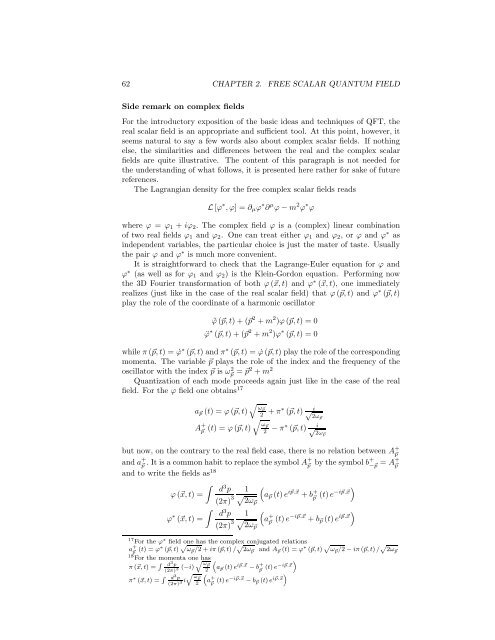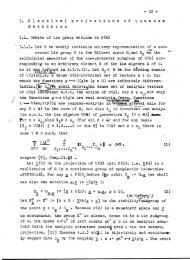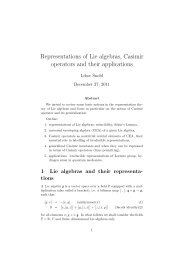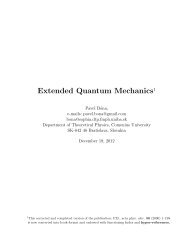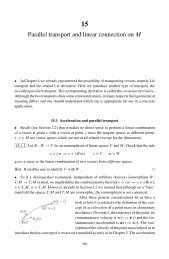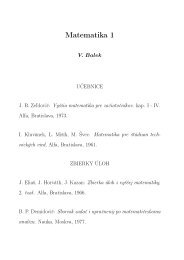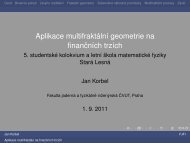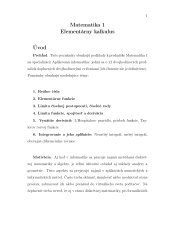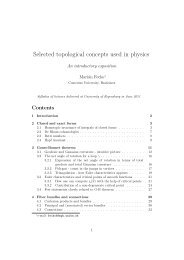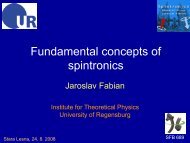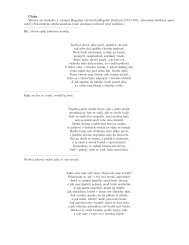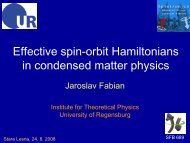Quantum Field Theory I
Quantum Field Theory I
Quantum Field Theory I
You also want an ePaper? Increase the reach of your titles
YUMPU automatically turns print PDFs into web optimized ePapers that Google loves.
62 CHAPTER 2. FREE SCALAR QUANTUM FIELD<br />
Side remark on complex fields<br />
For the introductory exposition of the basic ideas and techniques of QFT, the<br />
real scalar field is an appropriate and sufficient tool. At this point, however, it<br />
seems natural to say a few words also about complex scalar fields. If nothing<br />
else, the similarities and differences between the real and the complex scalar<br />
fields are quite illustrative. The content of this paragraph is not needed for<br />
the understanding of what follows, it is presented here rather for sake of future<br />
references.<br />
The Lagrangian density for the free complex scalar fields reads<br />
L[ϕ ∗ ,ϕ] = ∂ µ ϕ ∗ ∂ µ ϕ−m 2 ϕ ∗ ϕ<br />
where ϕ = ϕ 1 + iϕ 2 . The complex field ϕ is a (complex) linear combination<br />
of two real fields ϕ 1 and ϕ 2 . One can treat either ϕ 1 and ϕ 2 , or ϕ and ϕ ∗ as<br />
independent variables, the particular choice is just the mater of taste. Usually<br />
the pair ϕ and ϕ ∗ is much more convenient.<br />
It is straightforward to check that the Lagrange-Euler equation for ϕ and<br />
ϕ ∗ (as well as for ϕ 1 and ϕ 2 ) is the Klein-Gordon equation. Performing now<br />
the 3D Fourier transformation of both ϕ(⃗x,t) and ϕ ∗ (⃗x,t), one immediately<br />
realizes (just like in the case of the real scalar field) that ϕ(⃗p,t) and ϕ ∗ (⃗p,t)<br />
play the role of the coordinate of a harmonic oscillator<br />
¨ϕ(⃗p,t)+(⃗p 2 +m 2 )ϕ(⃗p,t) = 0<br />
¨ϕ ∗ (⃗p,t)+(⃗p 2 +m 2 )ϕ ∗ (⃗p,t) = 0<br />
while π(⃗p,t) = ˙ϕ ∗ (⃗p,t) and π ∗ (⃗p,t) = ˙ϕ(⃗p,t) play the role of the corresponding<br />
momenta. The variable ⃗p plays the role of the index and the frequency of the<br />
oscillator with the index ⃗p is ω 2 ⃗p = ⃗p2 +m 2<br />
Quantization of each mode proceeds again just like in the case of the real<br />
field. For the ϕ field one obtains 17<br />
ω⃗p<br />
a ⃗p (t) = ϕ(⃗p,t)√<br />
2 +π∗ i<br />
(⃗p,t) √<br />
2ω⃗p<br />
√<br />
A + ⃗p (t) = ϕ(⃗p,t) ω⃗p<br />
2 −π∗ i<br />
(⃗p,t) √<br />
2ω⃗p<br />
but now, on the contrary to the real field case, there is no relation between A + ⃗p<br />
and a + ⃗p . It is a common habit to replace the symbol A+ ⃗p by the symbol b+ −⃗p = A+ ⃗p<br />
and to write the fields as 18<br />
∫<br />
ϕ(⃗x,t) =<br />
∫<br />
ϕ ∗ (⃗x,t) =<br />
d 3 p<br />
(2π) 3 1<br />
√<br />
2ω⃗p<br />
(<br />
a ⃗p (t)e i⃗p.⃗x +b + ⃗p (t)e−i⃗p.⃗x)<br />
d 3 p 1<br />
(<br />
(2π) 3 √ a + ⃗p (t)e−i⃗p.⃗x +b ⃗p (t)e i⃗p.⃗x)<br />
2ω⃗p<br />
17 For the ϕ ∗ field one has the complex conjugated relations<br />
a + ⃗p (t) = ϕ∗ (⃗p,t) √ ω ⃗p /2+iπ(⃗p,t)/ √ 2ω ⃗p and A ⃗p (t) = ϕ ∗ (⃗p,t) √ ω ⃗p /2−iπ(⃗p,t)/ √ 2ω ⃗p<br />
18 For the momenta one has<br />
π(⃗x,t) = ∫ √<br />
d 3 p ω⃗p<br />
)<br />
(2π) 3 (−i)<br />
(a 2 ⃗p (t)e i⃗p.⃗x −b + ⃗p (t)e−i⃗p.⃗x<br />
π ∗ (⃗x,t) = ∫ √<br />
d 3 p ω⃗p<br />
)<br />
(2π) 3 i<br />
(a + 2 ⃗p (t)e−i⃗p.⃗x −b ⃗p (t)e i⃗p.⃗x


